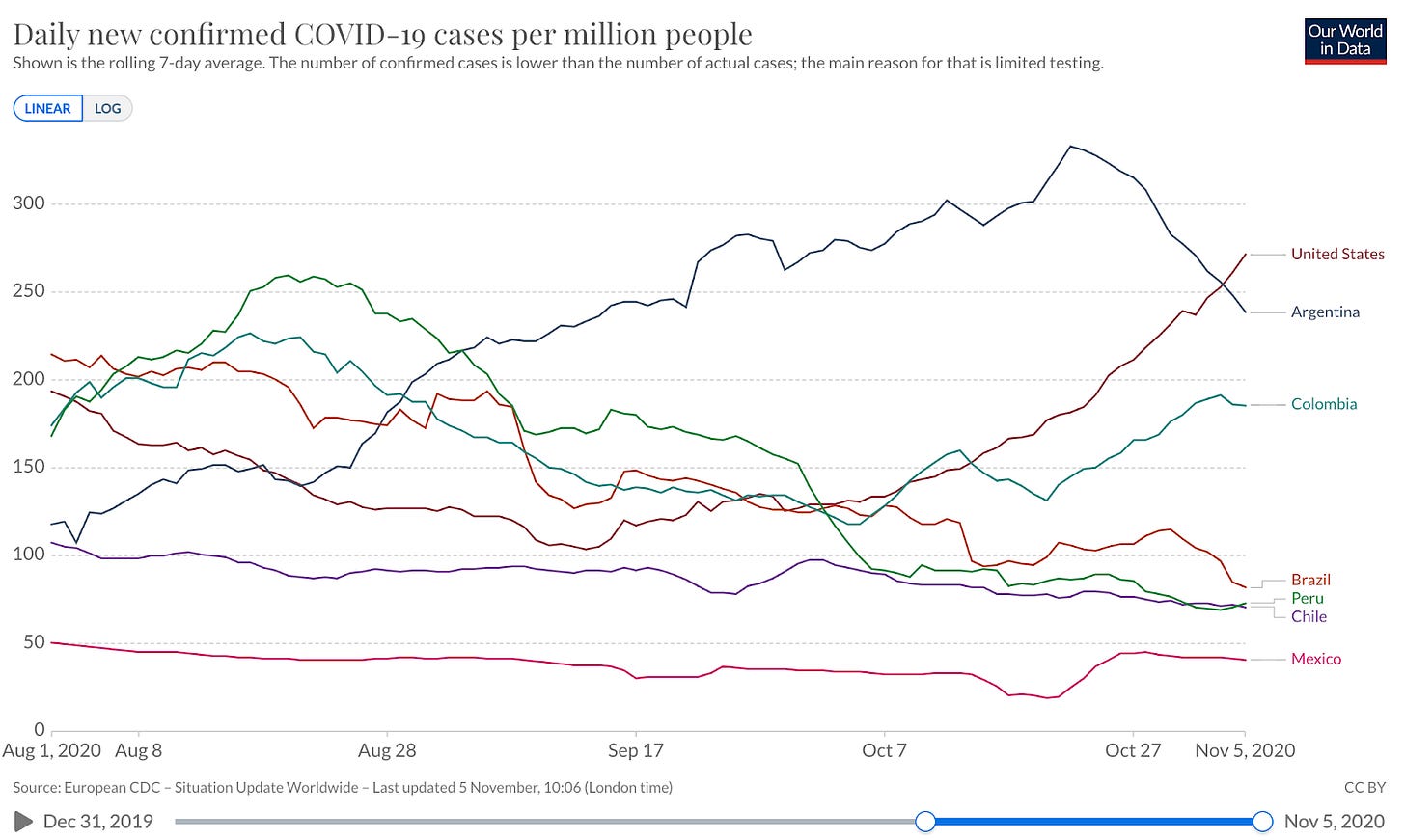Recent trends in COVID-19 in the hemisphere
Central America's Northern Triangle must now deal with the aftermath of Hurricane Eta while also fighting the pandemic
Source: Our World in Data
The chart above looks at the seven day averages of new coronavirus cases per capita. I started the chart on 1 August to highlight the recent trends in some of the larger countries in the hemisphere.
Argentina finally appears to have peaked and the numbers of new cases have been dropping quite rapidly in the past two weeks. However, while the trend is good, the numbers of reported daily new cases are still among the worst in Latin America.
Colombia made progress for much of September but has seen a new rise in cases over the past few weeks. This is likely due to the reopening of restaurants and businesses in September.
Brazil and Peru have both seen substantial progress in the past three month in reducing their cases from their peak levels. Both have cut the number of new cases per day in half. Chile has made some progress as well, though not quite as dramatic.
Mexico serves as a reminder that the entire chart above is “reported cases.” Mexico has some of the lowest per capita reported cases in a major country and one of the highest case fatality rates in the world because they are avoiding expanding testing and reporting cases. As I wrote recently, the number of excess deaths also shows they have underreported the numbers of deaths from coronavirus.
Cases remain high in Costa Rica and Panama
Above: From Our World in Data
Some readers have asked me to cover other countries, so above is the chart for Central America since 1 August.
Belize went from practically zero recorded cases at the beginning of the time frame to a steady and then sharp rise. To be fair, the country only has about 400,000 people and the rise per capita reflects a shift to about 100 new cases per day. But it’s still a potential concern to the country’s healthcare system.
Costa Rica saw a significant spike in cases in August and perhaps a very gradual reduction in October. It’s still right near Argentina’s levels in terms of being among the worst in the hemisphere.
Panama made significant progress in August in terms of reducing cases from one of the highest per capita levels in the hemisphere. However, the number of new cases per day remains troublingly high, more similar to Colombia than to most of its Central American neighbors.
Both El Salvador and Guatemala have halved their reported cases since the beginning of August. Honduras has managed to remain relatively steady. It’s likely that the countries are under-testing relative to Costa Rica and Panama, but reporting on the ground suggests there haven’t been large spikes that contradict the general trends seen in these charts.
Nicaragua’s reporting on coronavirus is a joke as the Ortega regime covers up the actual numbers of cases and deaths. I included it on the chart so you can see just how absurd their reporting is. I don’t know what the actual numbers are, but to give a geographic answer, somewhere between Honduras and Costa Rica would be a fairly good guess.
Many of these countries, particularly Nicaragua and Honduras, must now deal with the aftermath of Hurricane Eta. There is a potential that the challenges of recovery from the natural disaster will cause cases to spike. It’s also a reminder that if other natural disasters strike, many of these countries’ capacities to respond are already strained.
Thanks for reading
If you want to be added to the newsletter distribution list, please enter your email at https://boz.substack.com/ or email me at boz@substack.com and I will add you.




